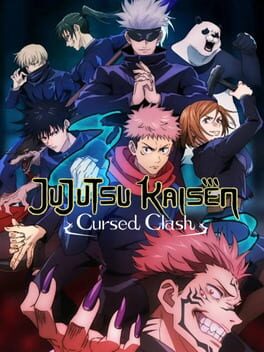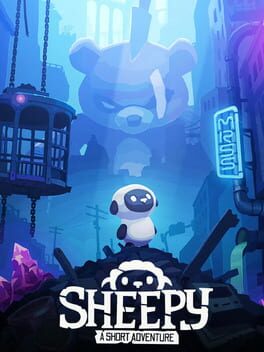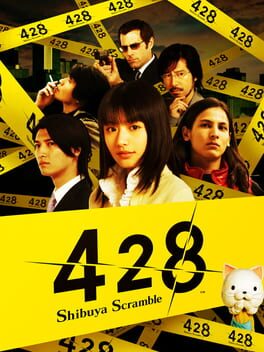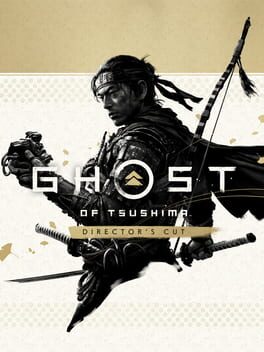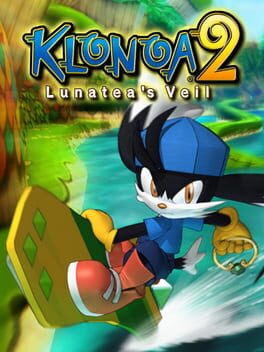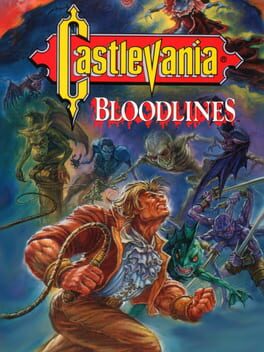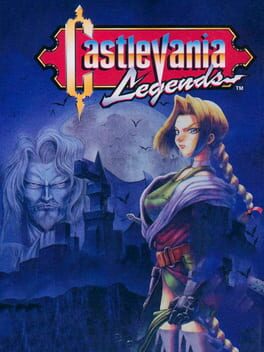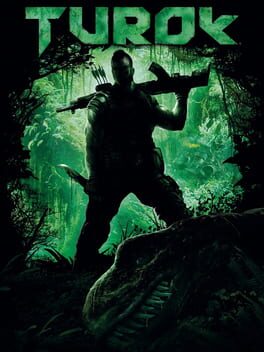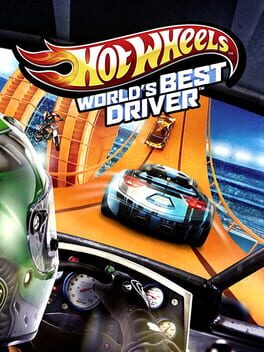7611 Reviews liked by Vee
Castlevania ReVamped
2024
In my time using this site I never thought I'd be going through the process of getting a game added on IGDB just so I can tell people that it's cool and that they should play it, but here we are.
Castlevania ReVamped is an odd game. Odd in the sense that it dropped out of nowhere, and that nobody has been talking about it. It's a remake and a reimagining of Castlevania 1 - not as a traditional, level-based platformer but as a metroidvania - and it actually works!
Simon Belmont's first encounter with Dracula has been retold and reimagined half a dozen times by this point, and ReVamped opts to take aspects of all of them, and in so doing creates what I believe to be the definitive retelling. There's areas and music from Castlevania 1 and X68000 Akumajou Dracula (better known as Castlevania Chronicles), the diagonal whipping from Castlevania IV, and hell, really obscure stuff like the merchants from Vampire Killer on the MSX. It's a genuine labour of love for this franchise and I feel that's something that really sets it apart from most other Castlevania fangames.
Castlevania ReVamped isn't trying to "fix" something like those numerous Castlevania II fan remakes are. And it's more than just a character insertion like the many GBA and DSvania mods. It's an entirely new game made by a fan, for fans, and I can attest to its quality by saying I beat it in a single sitting; it's that good.
Castlevania ReVamped is an odd game. Odd in the sense that it dropped out of nowhere, and that nobody has been talking about it. It's a remake and a reimagining of Castlevania 1 - not as a traditional, level-based platformer but as a metroidvania - and it actually works!
Simon Belmont's first encounter with Dracula has been retold and reimagined half a dozen times by this point, and ReVamped opts to take aspects of all of them, and in so doing creates what I believe to be the definitive retelling. There's areas and music from Castlevania 1 and X68000 Akumajou Dracula (better known as Castlevania Chronicles), the diagonal whipping from Castlevania IV, and hell, really obscure stuff like the merchants from Vampire Killer on the MSX. It's a genuine labour of love for this franchise and I feel that's something that really sets it apart from most other Castlevania fangames.
Castlevania ReVamped isn't trying to "fix" something like those numerous Castlevania II fan remakes are. And it's more than just a character insertion like the many GBA and DSvania mods. It's an entirely new game made by a fan, for fans, and I can attest to its quality by saying I beat it in a single sitting; it's that good.
Castlevania ReVamped
2024
It's short, it's got a nice double jump. 3 stars, good outing. That's a nice score, right? Fair?
… now drag him.
There's going to be some mechanical spoilers ahead, maybe a mild story peek. Worried about that? Go play the game. It's free, takes an hour. I'll wait.
…
Right. Somebody really, really likes the Ori games. Good taste! Good games. Well, the first one. And not the Definitive Edition, that one ruins the balance. And I'm not really sure about the second, I haven't played it. But I know a guy who knows a guy that worked on them, and I like the former of those guys, so I'll take it on good faith.
The thing about Ori is its breadth and temerity. It's a wide game. Lots of secrets to discover, ways to move, terrain to traverse. Movement is polished, fluid. Everything has a lovely watercolor look to it that gives it a natural warmth. Lush orchestral sweeps occasionally punctuate major story moments. Solid, coherent, full of subtle design motifs that quietly tie it all together. And, importantly: it has the courage to challenge the player. Not that much, mind, but consequences make mastery meaningful, and Ori brings them.
Sheepy does not. Sheepy is a Thomas Kincaid fan looking at Ori and wanting to do the same. Nothing wrong with that, inspiration and imitation are the cornerstones of art. But the mark is missed. An overreliance on colored lighting to bring warmth, literally signposted secrets that are desperate to be discovered, the standard movement upgrades of double jump and dash and the final super traversal move, all thrown in quick succession before any real exploration or challenge can be laid out. And the latter two of those do not work properly - or at all - with the D-pad, despite the game letting you control the titular character with the same with no complaint otherwise.
How about the sound? The music is grand, sweeping yet pallid. The reverbating swell when a large new area is met, the piano in minor key throughout, the breathless, freedom-espousing sprint that accompanies an utterly toothless and far too long sprint. It's well done, no doubt. But it's uninspired, rote, far too self-aware and far too eager to be heard.
And the combat. Three of those, one hit kills for young Sheepy, dramatic setups so out of place the eyes can't help but roll. And when you die - swiftly - you'll quickly run into the fact that you'll be watching those lengthy cutscene setups again. Mash some buttons, try to skip. "Hold Y to skip"? Lies. Hold Y to fast-forward, complete with audio distortion. The final battle doesn't even have the teeth to resist giving the player multiple checkpoints to complete its internal logic-defying completion steps.
There's a story here, rather vague, rather pointless. I read all the notes, listened to all the tapes. It has nothing to say, and ends in a vague, embarrassing pile. A shining example of tell, don't show.
As a result the entire affair absolutely screams capstone project, the final final of some game design college, a game drenched in amateur polish and carrying a backpack full of the inspirations that drove its creators to enroll in the first place.
But hey, it's free. 3 stars.
… now drag him.
There's going to be some mechanical spoilers ahead, maybe a mild story peek. Worried about that? Go play the game. It's free, takes an hour. I'll wait.
…
Right. Somebody really, really likes the Ori games. Good taste! Good games. Well, the first one. And not the Definitive Edition, that one ruins the balance. And I'm not really sure about the second, I haven't played it. But I know a guy who knows a guy that worked on them, and I like the former of those guys, so I'll take it on good faith.
The thing about Ori is its breadth and temerity. It's a wide game. Lots of secrets to discover, ways to move, terrain to traverse. Movement is polished, fluid. Everything has a lovely watercolor look to it that gives it a natural warmth. Lush orchestral sweeps occasionally punctuate major story moments. Solid, coherent, full of subtle design motifs that quietly tie it all together. And, importantly: it has the courage to challenge the player. Not that much, mind, but consequences make mastery meaningful, and Ori brings them.
Sheepy does not. Sheepy is a Thomas Kincaid fan looking at Ori and wanting to do the same. Nothing wrong with that, inspiration and imitation are the cornerstones of art. But the mark is missed. An overreliance on colored lighting to bring warmth, literally signposted secrets that are desperate to be discovered, the standard movement upgrades of double jump and dash and the final super traversal move, all thrown in quick succession before any real exploration or challenge can be laid out. And the latter two of those do not work properly - or at all - with the D-pad, despite the game letting you control the titular character with the same with no complaint otherwise.
How about the sound? The music is grand, sweeping yet pallid. The reverbating swell when a large new area is met, the piano in minor key throughout, the breathless, freedom-espousing sprint that accompanies an utterly toothless and far too long sprint. It's well done, no doubt. But it's uninspired, rote, far too self-aware and far too eager to be heard.
And the combat. Three of those, one hit kills for young Sheepy, dramatic setups so out of place the eyes can't help but roll. And when you die - swiftly - you'll quickly run into the fact that you'll be watching those lengthy cutscene setups again. Mash some buttons, try to skip. "Hold Y to skip"? Lies. Hold Y to fast-forward, complete with audio distortion. The final battle doesn't even have the teeth to resist giving the player multiple checkpoints to complete its internal logic-defying completion steps.
There's a story here, rather vague, rather pointless. I read all the notes, listened to all the tapes. It has nothing to say, and ends in a vague, embarrassing pile. A shining example of tell, don't show.
As a result the entire affair absolutely screams capstone project, the final final of some game design college, a game drenched in amateur polish and carrying a backpack full of the inspirations that drove its creators to enroll in the first place.
But hey, it's free. 3 stars.
I'm not going to mince words here, this is by far one of the worst, most frustrating games I've ever played. There are plenty of NES games that have stood the test of time and remain playable and fun till this day, still regarded as classics of the medium.
This game isn't one of them.
This is cock and ball torture.
The biggest problem this game has is it's enemy design. Enemies hit hard, fast and randomly, seldomly giving you a chance to get a clean strike on them. You'll almost never escape an encounter unscathed.
I had a brief moment in the game were I was enjoying myself, having just finished the first Palace and gaining my first item, the candle. Now I could finally explore dark caves! Then I got to Death Mountain, probably the hardest section in the game and the frustration began anew. Even though you'll progress and "grow stronger", you never feel like you're well- equiped for the journey ahead.
Glad this one's over with.
This game isn't one of them.
This is cock and ball torture.
The biggest problem this game has is it's enemy design. Enemies hit hard, fast and randomly, seldomly giving you a chance to get a clean strike on them. You'll almost never escape an encounter unscathed.
I had a brief moment in the game were I was enjoying myself, having just finished the first Palace and gaining my first item, the candle. Now I could finally explore dark caves! Then I got to Death Mountain, probably the hardest section in the game and the frustration began anew. Even though you'll progress and "grow stronger", you never feel like you're well- equiped for the journey ahead.
Glad this one's over with.
One Piece Tetris
2004
Ridge Racer Type 4
1998
I’ve been thinking a lot about storytelling in video games lately. Well, storytelling as a whole actually. What exactly makes a fictional world feel compelling to me? How should you best spin a yarn as to make the characters breathe, their struggles resonate, and their victories triumphant? Most importantly, if a writer did have the vision and the wherewithal to execute said vision, then how could they best convince their audience that their vision was worth their time?
This week, I might have come a step closer to realizing those answers by revisiting an old favorite of mine.
428: Shibuya Scramble is not just your ordinary traditional visual novel. It’s a crime thriller, a romantic comedy, and an investigative journalism drama all rolled into one. That description alone could sell the game, but the crazy part is that the narrative is just the icing on top of this deceptively layered and charismatic tale. The game's greatest strength is not just what it has to say, but rather how it says it.
As I've discussed previously, many story-heavy games have difficulty integrating their storytelling and their gameplay, often choosing to stratify their game into separate sections of explicit narrative and explicit gameplay. 428 Shibuya Scramble does not struggle with this whatsoever, for the interaction with the narrative is the gameplay and it presents its story in such a way where every detail matters. You see, 428: Shibuya Scramble operates in hourly time slots with several protagonists at once. The goal is to guide each protagonist on their separate storyline and ensure that every protagonist makes it to the end of each hour by making the correct decisions and avoiding untimely demise through bad ends. However, there’s a catch. Protagonists can reach bad ends on their own paths even if every decision they make within their contained storyline is “correct.” This is because these different storylines intersect one another in various ways, and decisions made with one character will ultimately echo throughout the hour, affecting the other protagonists in unforeseen ways.
As such, the player isn’t doing anything mechanically complex aside from reading text and picking the right options most of the time, which means that like the best detective games, 428 is really about the game outside of the game. The player has to figure out how the butterfly effect ripples across each hour, even as characters often impact one another without ever coming face to face. For example, one of the characters can become incapacitated by consuming a potent energy drink on the job; you can avoid this bad end by making sure an earlier character fails to provide his detective partner with the lethal sample. While the nature of these intersections is often unclear, 428 revels in this uncertainty. It’s not content with simply using its bad ends as punishments; rather, it grasps these bad ends as opportunities to inject additional lore and guide the player towards the truth. These bad ends are often light-hearted and comedic just as they are valuable learning opportunities, and somehow the game walks the tightrope between solemnity and levity without ever losing sincerity. Simply put, most story-heavy games are constantly asking the five Ws, but 428 Shibuya Scramble is one of the rare whimsical games that dares ask “What if?”
On a similar note, a lot of players tend to get frustrated by 428’s habit of barricading individual protagonist paths with “KEEP OUT” banners, but I find this mechanic to be a stroke of genius. In order to clear these barricades, players are forced to traverse other protagonists’ stories in the meanwhile and search for a “JUMP” point linking them back to the original blocked protagonist. By doing so, they’re often hopping around the hour and viewing events from multiple parallel perspectives, gathering more information to better grasp how the timelines intertwine. Moreover, the game fully commits to this idea of rounding out its narrative by even hiding JUMP points behind certain decisions that would otherwise have no bearing upon story events (i.e. “flavor text questions/decisions”) and certain TIPs (blue colored text that when selected, provides additional background). This keeps the player vigilant, as they’re constantly on the prowl for connections while soaking in every detail and considering every possibility to push the plot forward.
Of course, this is not to take away from the game’s multitude of other strengths. For instance, consider the game’s sound design. From hurried footsteps and screeching cars in high-speed chases to distant explosions and sirens spelling imminent doom, Chunsoft knew just how to punctuate every moment with appropriate sound effects. Another obvious selling point is 428’s reliance upon live action stills and full motion video, which aside from standing out from other sketched and animated visual novels, provides the game a sense of immersion and realism that interestingly often contrasts with the game’s over-the-top sense of humor. Finally, the actors do a great job emoting and infusing their lines with personality despite the lack of voice acting. Alongside the phenomenal character design, written in such a way where every character has obvious flaws yet remain every bit relatable, there’s a certain charm to 428 Shibuya Scramble that many of its peers fail to imitate. As a complete and tightly-knit package, its artistic decisions and gameplay mechanics do not simply capture Shibuya; they perpetuate the energy of the city, enthralling and surprising the player at every turn.
I’m often reluctant to revisit beloved titles. More often than not, giving old favorites another spin with a more critical eye or even thinking about them for too long causes them to deteriorate somewhat in my mind, forcing me to confront my prior nostalgia. It’s never a great feeling to question yourself if something you once loved was really all that great to begin with. 428 is the exact opposite of this. Don’t get me wrong; the game does have some rough points. The inability to adjust text speed and skip previously read text can be a huge ask for players with limited time (though if you’re playing on PC, the unofficial text speed patch alleviates this somewhat), and I find myself agreeing with others in that the true ending leaves something to be desired. I won’t deny that I had some apprehensions upon replaying yet another memorable classic.
Yet somehow, this game has lived rent-free in my head for over half a decade. I had intended to replay it for just an hour or two to refresh my palette, as I had already 100%ed it and wanted to move onto newer and grander adventures. In spite of that, I found myself with the exact opposite problem. I simply could not put the game down. 428 Shibuya Scramble is the rare example of a game that to me, never stops getting better. Playing through it again immediately reminded me of why I fell in love with video games to begin with, and it didn’t matter that I had seen the destination already; the thrill of the journey was enough to make me return. I’m sure that I could ponder more areas of improvement and potential fixes, though honestly, I can’t bring myself to care. There aren’t many games that I unabashedly adore and wish for more, but there are even fewer games that manage to spark my Imagination and leave me content with what I have. At the end of the day, 428: Shibuya Scramble is not just a triumph of the medium; it's a triumph of human inevitability, gathering momentum until coincidence and fate become reality. I may have become more cynical over time, but it's moments like these that prove that sometimes, it really does pay to believe.
This week, I might have come a step closer to realizing those answers by revisiting an old favorite of mine.
428: Shibuya Scramble is not just your ordinary traditional visual novel. It’s a crime thriller, a romantic comedy, and an investigative journalism drama all rolled into one. That description alone could sell the game, but the crazy part is that the narrative is just the icing on top of this deceptively layered and charismatic tale. The game's greatest strength is not just what it has to say, but rather how it says it.
As I've discussed previously, many story-heavy games have difficulty integrating their storytelling and their gameplay, often choosing to stratify their game into separate sections of explicit narrative and explicit gameplay. 428 Shibuya Scramble does not struggle with this whatsoever, for the interaction with the narrative is the gameplay and it presents its story in such a way where every detail matters. You see, 428: Shibuya Scramble operates in hourly time slots with several protagonists at once. The goal is to guide each protagonist on their separate storyline and ensure that every protagonist makes it to the end of each hour by making the correct decisions and avoiding untimely demise through bad ends. However, there’s a catch. Protagonists can reach bad ends on their own paths even if every decision they make within their contained storyline is “correct.” This is because these different storylines intersect one another in various ways, and decisions made with one character will ultimately echo throughout the hour, affecting the other protagonists in unforeseen ways.
As such, the player isn’t doing anything mechanically complex aside from reading text and picking the right options most of the time, which means that like the best detective games, 428 is really about the game outside of the game. The player has to figure out how the butterfly effect ripples across each hour, even as characters often impact one another without ever coming face to face. For example, one of the characters can become incapacitated by consuming a potent energy drink on the job; you can avoid this bad end by making sure an earlier character fails to provide his detective partner with the lethal sample. While the nature of these intersections is often unclear, 428 revels in this uncertainty. It’s not content with simply using its bad ends as punishments; rather, it grasps these bad ends as opportunities to inject additional lore and guide the player towards the truth. These bad ends are often light-hearted and comedic just as they are valuable learning opportunities, and somehow the game walks the tightrope between solemnity and levity without ever losing sincerity. Simply put, most story-heavy games are constantly asking the five Ws, but 428 Shibuya Scramble is one of the rare whimsical games that dares ask “What if?”
On a similar note, a lot of players tend to get frustrated by 428’s habit of barricading individual protagonist paths with “KEEP OUT” banners, but I find this mechanic to be a stroke of genius. In order to clear these barricades, players are forced to traverse other protagonists’ stories in the meanwhile and search for a “JUMP” point linking them back to the original blocked protagonist. By doing so, they’re often hopping around the hour and viewing events from multiple parallel perspectives, gathering more information to better grasp how the timelines intertwine. Moreover, the game fully commits to this idea of rounding out its narrative by even hiding JUMP points behind certain decisions that would otherwise have no bearing upon story events (i.e. “flavor text questions/decisions”) and certain TIPs (blue colored text that when selected, provides additional background). This keeps the player vigilant, as they’re constantly on the prowl for connections while soaking in every detail and considering every possibility to push the plot forward.
Of course, this is not to take away from the game’s multitude of other strengths. For instance, consider the game’s sound design. From hurried footsteps and screeching cars in high-speed chases to distant explosions and sirens spelling imminent doom, Chunsoft knew just how to punctuate every moment with appropriate sound effects. Another obvious selling point is 428’s reliance upon live action stills and full motion video, which aside from standing out from other sketched and animated visual novels, provides the game a sense of immersion and realism that interestingly often contrasts with the game’s over-the-top sense of humor. Finally, the actors do a great job emoting and infusing their lines with personality despite the lack of voice acting. Alongside the phenomenal character design, written in such a way where every character has obvious flaws yet remain every bit relatable, there’s a certain charm to 428 Shibuya Scramble that many of its peers fail to imitate. As a complete and tightly-knit package, its artistic decisions and gameplay mechanics do not simply capture Shibuya; they perpetuate the energy of the city, enthralling and surprising the player at every turn.
I’m often reluctant to revisit beloved titles. More often than not, giving old favorites another spin with a more critical eye or even thinking about them for too long causes them to deteriorate somewhat in my mind, forcing me to confront my prior nostalgia. It’s never a great feeling to question yourself if something you once loved was really all that great to begin with. 428 is the exact opposite of this. Don’t get me wrong; the game does have some rough points. The inability to adjust text speed and skip previously read text can be a huge ask for players with limited time (though if you’re playing on PC, the unofficial text speed patch alleviates this somewhat), and I find myself agreeing with others in that the true ending leaves something to be desired. I won’t deny that I had some apprehensions upon replaying yet another memorable classic.
Yet somehow, this game has lived rent-free in my head for over half a decade. I had intended to replay it for just an hour or two to refresh my palette, as I had already 100%ed it and wanted to move onto newer and grander adventures. In spite of that, I found myself with the exact opposite problem. I simply could not put the game down. 428 Shibuya Scramble is the rare example of a game that to me, never stops getting better. Playing through it again immediately reminded me of why I fell in love with video games to begin with, and it didn’t matter that I had seen the destination already; the thrill of the journey was enough to make me return. I’m sure that I could ponder more areas of improvement and potential fixes, though honestly, I can’t bring myself to care. There aren’t many games that I unabashedly adore and wish for more, but there are even fewer games that manage to spark my Imagination and leave me content with what I have. At the end of the day, 428: Shibuya Scramble is not just a triumph of the medium; it's a triumph of human inevitability, gathering momentum until coincidence and fate become reality. I may have become more cynical over time, but it's moments like these that prove that sometimes, it really does pay to believe.
Mega Man ZX Advent
2007
Something of a planned sequel, but also quite the encore title focusing this time on alot of the remaining aspects of the Mega Man franchise - most notably including the forgotten stepchild of the X series, Axl. After ZX allowed you to tranform into the various prominent “Mega Men” of the previous games, ZXA taking advantage of Axls legacy powers to allow players to transform into the Maverick bosses as well (with some exception) is a no-brainer - an aspect which also brings the ZX series in greater alignment with the power-stealing foundations of the Classic series.
While the already limited metroidvania aspects of the first game take an even greater backseat in ZXA, what youre left with is still a fairly fresh and substantial open-roam Mega Man game made naturally rewarding with the powers of Model A - boss forms provide both interesting combat and traversal variety, which impacts level design in some compelling ways. The roster of bosses itself is stacked, ranking probably among the best in the franchise. ZXA even picks the ball up from Zero's Dr Weil by introducing an even more direct Dr Wily analogue with "Albert", bringing the Greatest Hits tour full circle in Ouroborosian fashion.
While the already limited metroidvania aspects of the first game take an even greater backseat in ZXA, what youre left with is still a fairly fresh and substantial open-roam Mega Man game made naturally rewarding with the powers of Model A - boss forms provide both interesting combat and traversal variety, which impacts level design in some compelling ways. The roster of bosses itself is stacked, ranking probably among the best in the franchise. ZXA even picks the ball up from Zero's Dr Weil by introducing an even more direct Dr Wily analogue with "Albert", bringing the Greatest Hits tour full circle in Ouroborosian fashion.
Finally got around to playing this game after replaying the hell out of the first one a good few times. It goes insane.
It's a crazy pretty game, the visual style is just perfect, they went for something different than the first game and they just nailed it dude, I would stop moving sometimes to just look at stuff, it is GREAT. Every area is just full of detail and personality and stuff it ROCKS.
The new characters are all just really nice, there's a lot more going on than in the previous game, I love Lolo she's epic awesome she's Lammy coded... I used to think the design for Klonoa himself was weaker than the og but honestly they were kinda cooking with his fresh new look...
Music is incredible just like before, lot of variety in sounds and it's just really cool all around. There were a lil couple instances of penis music later in the game but not enough to really complain about it.
I loved that bit in the first game where after you finished a level you'd get a lil tune depending on how many guys you saved and it's not here and it made me sad ngl I love the lil music guys.
As for gameplay they added a lot of cool new mechanics and they really take advantage of em and it makes for really cool puzzle platforming, was having a blast, but I kinda didn't fuck with the gimmick board stages that much? Not that they're bad they're just whatever I guess.
All in all it was a really damn good game, I just kinda liked the first one more, it felt more consistently good even if 2 goes harder in some areas.
Also with it all being 3d models you'd think it'd translate better than the first game to that phantasy reverie remaster but NO they just fucked it up BAD holy cow. Please play the og if you do ever play it PLEASE.
It's a crazy pretty game, the visual style is just perfect, they went for something different than the first game and they just nailed it dude, I would stop moving sometimes to just look at stuff, it is GREAT. Every area is just full of detail and personality and stuff it ROCKS.
The new characters are all just really nice, there's a lot more going on than in the previous game, I love Lolo she's epic awesome she's Lammy coded... I used to think the design for Klonoa himself was weaker than the og but honestly they were kinda cooking with his fresh new look...
Music is incredible just like before, lot of variety in sounds and it's just really cool all around. There were a lil couple instances of penis music later in the game but not enough to really complain about it.
I loved that bit in the first game where after you finished a level you'd get a lil tune depending on how many guys you saved and it's not here and it made me sad ngl I love the lil music guys.
As for gameplay they added a lot of cool new mechanics and they really take advantage of em and it makes for really cool puzzle platforming, was having a blast, but I kinda didn't fuck with the gimmick board stages that much? Not that they're bad they're just whatever I guess.
All in all it was a really damn good game, I just kinda liked the first one more, it felt more consistently good even if 2 goes harder in some areas.
Also with it all being 3d models you'd think it'd translate better than the first game to that phantasy reverie remaster but NO they just fucked it up BAD holy cow. Please play the og if you do ever play it PLEASE.
The last of the Classicvania's before I enter into the era of Metroidvanias started by Symphony of the Night, Castlevania: Bloodlines ends the classic era with a bang.
The premise is cool as it takes place generations after the original Castlevania stories where you get to revisit some locales and see the aftermath of the destroyed Castlevania. It is also a globe trotting Castlevania as you get to visit many different places around Europe which gives a lot of diverse settings like a jungle, factory, castle etc. The diverse themes of the levels kept the game interesting all the way through.
While I didn't like this as much as Super Castlevania IV, I did enjoy it as much as Rondo of Blood. The game is closest to that game gameplay-wise but you do get restricted directional whipping. Not Castlevania IV 8 directional whipping but you can whip diagonally up left or right only while jumping. Still much better than not being able to whip diagonally at all and it was very useful in many scenarios. You can also use the diagonal whip as a rope to swing on if you manage to whip a ceiling, but I didn't find much use for it besides the few mandatory platforming sections that needed it.
One of the coolest new features I really like from Bloodlines is the fact that if your whip is upgraded to max, but you collect one more whip upgrade you get a blue magic laser whip that utterly destroys everything. Although if you get hit once you lose the magic and just go back to the maximum upgraded standard whip. This keep it more balanced and adds an extra challenge of not trying to get hit at all so you can keep the blue magic whip.
Balance-wise the game was very manageable the entire way through bar one of the bosses that had like 4 different forms and the boss rush at the very end that relied only on one health bar. I would say the game was well balanced if it weren't for those massive boss difficulty spikes. Also I'm never a fan of limited continues, especially in a game as hard as Castlevania. But if you are playing this on an emulator, you can always "modernize" this game and give yourself unlimited continues if you know what I mean. I am a full-time working adult and don't have the time to play through the entire game again if I run out of continues after all.
As I say goodbye to classicvania with a great final game, I look forward to the road ahead in the Metroidvania era. I mean can you believe that Metroidvanias are one of the my favorite all time genre's yet I haven't played Symphonoy of the Night? There are so many games to clear in the Metroidvania era so I'm am somewhat relieved to be done with Classicvania, yet I will remember my time with these games fondly.
The premise is cool as it takes place generations after the original Castlevania stories where you get to revisit some locales and see the aftermath of the destroyed Castlevania. It is also a globe trotting Castlevania as you get to visit many different places around Europe which gives a lot of diverse settings like a jungle, factory, castle etc. The diverse themes of the levels kept the game interesting all the way through.
While I didn't like this as much as Super Castlevania IV, I did enjoy it as much as Rondo of Blood. The game is closest to that game gameplay-wise but you do get restricted directional whipping. Not Castlevania IV 8 directional whipping but you can whip diagonally up left or right only while jumping. Still much better than not being able to whip diagonally at all and it was very useful in many scenarios. You can also use the diagonal whip as a rope to swing on if you manage to whip a ceiling, but I didn't find much use for it besides the few mandatory platforming sections that needed it.
One of the coolest new features I really like from Bloodlines is the fact that if your whip is upgraded to max, but you collect one more whip upgrade you get a blue magic laser whip that utterly destroys everything. Although if you get hit once you lose the magic and just go back to the maximum upgraded standard whip. This keep it more balanced and adds an extra challenge of not trying to get hit at all so you can keep the blue magic whip.
Balance-wise the game was very manageable the entire way through bar one of the bosses that had like 4 different forms and the boss rush at the very end that relied only on one health bar. I would say the game was well balanced if it weren't for those massive boss difficulty spikes. Also I'm never a fan of limited continues, especially in a game as hard as Castlevania. But if you are playing this on an emulator, you can always "modernize" this game and give yourself unlimited continues if you know what I mean. I am a full-time working adult and don't have the time to play through the entire game again if I run out of continues after all.
As I say goodbye to classicvania with a great final game, I look forward to the road ahead in the Metroidvania era. I mean can you believe that Metroidvanias are one of the my favorite all time genre's yet I haven't played Symphonoy of the Night? There are so many games to clear in the Metroidvania era so I'm am somewhat relieved to be done with Classicvania, yet I will remember my time with these games fondly.
Castlevania Legends
1997
Yeah... not counting remakes, this was the last Castlevania game with the classic gameplay, and I have to say that, although I understand that many people are fond of it because it was part of their childhood or because they believe that having a female protagonist saves it, on the other hand, this game sucks and I think nothing justifies it.
Without exaggeration, this game feels like a prototype of Castlevania II Belmont's Revenge (the second GB game, released in 1991), which for some reason 6 years later Konami decided to release to get some easy money. Everything is a big step backwards from Belmont's Revenge, the gameplay feels slower and clunky, the graphics are less detailed, the level design is bland and boring. There's no challenge in the game, sure, you'll die a couple of times, but when you do it will be in the most boring way possible, because the enemies are positioned in ways that are simply annoying, but not challenging. It's too easy, and yet it's extremely tedious to play.
The game has some interesting concepts and mechanics, like for example, to unlock the true ending, you have to get the classic sub-weapons of the series (which for some strange reason you will NEVER be able to use), which adds that exploration factor to the game. The bad thing is that exploring in this game is annoying because of two things. The first is that there are a lot of paths that lead you to dead ends and don't reward you in anything, feeling like a waste of time, and besides that, there are also traps that lead you to some sort of arena where you have to defeat waves of monsters as punishment, and that's not the worst thing, the worst thing is that many times the enemies are positioned on a very small platform where it's hard to attack them since when you defeat them they reappear in the only places from where you can attack them, making you always take damage. They are a real nuisance, as they don't add anything of value to the experience. Secondly, if for some reason you went down the wrong path and forgot one of these special items, you block the possibility of accessing the true ending with no other option but to start from the beginning.
The true sub-weapons in the game are weird, these are powers which are obtained every time you defeat the boss of a level. What I like about this is that you have at your disposal the ability to swap sub-weapons on the fly by simply accessing the menu, however, these powers are very broken, the first one you get freezes time, and there is another one that wipes out all enemies on the screen.
You can also enter a “hyper-powered” mode if you press A+B, in which you are invulnerable to all attacks and greatly increases your movement speed. With this you'll defeat the bosses in no time.
Somehow, I feel that the developers put all those “interesting” elements as a way to “correct” a flaw in the game's design. For example, the powerful sub-weapons serve to compensate for the game's mediocre and annoying enemy positioning. The alternate paths “compensate” for the blandness of the level design. The hyper-powered mode compensates for the slow character movement. But to me, these additions more than fix the game make it much worse, because it implies that the developers knew the game wasn't that good and still decided to keep going.
Yes... I would talk about the story, but it's not worth it, it's sappy, it's nonsense and it's not even canon.
Conclusion
If Castlevania The Adventure was an admirable attempt to adapt the series to the GB (failing in said attempt), 8 years later, Castlevania Legends arrived to give it competition, but this also being the most unnecessary game of the franchise. I wish it was funny, but it's just sad.
At least Castlevania The Adventure is somewhat justifiable because it came out when the franchise was just starting, but this game? it came out after Symphony of the Night, after the classic formula had peaked more than once. Nothing redeems this bad game.
Without exaggeration, this game feels like a prototype of Castlevania II Belmont's Revenge (the second GB game, released in 1991), which for some reason 6 years later Konami decided to release to get some easy money. Everything is a big step backwards from Belmont's Revenge, the gameplay feels slower and clunky, the graphics are less detailed, the level design is bland and boring. There's no challenge in the game, sure, you'll die a couple of times, but when you do it will be in the most boring way possible, because the enemies are positioned in ways that are simply annoying, but not challenging. It's too easy, and yet it's extremely tedious to play.
The game has some interesting concepts and mechanics, like for example, to unlock the true ending, you have to get the classic sub-weapons of the series (which for some strange reason you will NEVER be able to use), which adds that exploration factor to the game. The bad thing is that exploring in this game is annoying because of two things. The first is that there are a lot of paths that lead you to dead ends and don't reward you in anything, feeling like a waste of time, and besides that, there are also traps that lead you to some sort of arena where you have to defeat waves of monsters as punishment, and that's not the worst thing, the worst thing is that many times the enemies are positioned on a very small platform where it's hard to attack them since when you defeat them they reappear in the only places from where you can attack them, making you always take damage. They are a real nuisance, as they don't add anything of value to the experience. Secondly, if for some reason you went down the wrong path and forgot one of these special items, you block the possibility of accessing the true ending with no other option but to start from the beginning.
The true sub-weapons in the game are weird, these are powers which are obtained every time you defeat the boss of a level. What I like about this is that you have at your disposal the ability to swap sub-weapons on the fly by simply accessing the menu, however, these powers are very broken, the first one you get freezes time, and there is another one that wipes out all enemies on the screen.
You can also enter a “hyper-powered” mode if you press A+B, in which you are invulnerable to all attacks and greatly increases your movement speed. With this you'll defeat the bosses in no time.
Somehow, I feel that the developers put all those “interesting” elements as a way to “correct” a flaw in the game's design. For example, the powerful sub-weapons serve to compensate for the game's mediocre and annoying enemy positioning. The alternate paths “compensate” for the blandness of the level design. The hyper-powered mode compensates for the slow character movement. But to me, these additions more than fix the game make it much worse, because it implies that the developers knew the game wasn't that good and still decided to keep going.
Yes... I would talk about the story, but it's not worth it, it's sappy, it's nonsense and it's not even canon.
Conclusion
If Castlevania The Adventure was an admirable attempt to adapt the series to the GB (failing in said attempt), 8 years later, Castlevania Legends arrived to give it competition, but this also being the most unnecessary game of the franchise. I wish it was funny, but it's just sad.
At least Castlevania The Adventure is somewhat justifiable because it came out when the franchise was just starting, but this game? it came out after Symphony of the Night, after the classic formula had peaked more than once. Nothing redeems this bad game.
Turok
2008
Does it have a Double Jump? No.
I only played 20 minutes because I can't stand the fucking fov (default is 65 apparently! like what!) and its a console shooter. It honestly kind of gave me Halo vibes because you are a military group crashing on a alien world to explore. Ron Pearlman voices someone in this game and it honestly did a lot for my brief enjoyment. I see there is a PC version, but even if I can fix all 2 things that made me quit, seeing from other reviews that it is mostly soldier shooting I will just refrain.
I only played 20 minutes because I can't stand the fucking fov (default is 65 apparently! like what!) and its a console shooter. It honestly kind of gave me Halo vibes because you are a military group crashing on a alien world to explore. Ron Pearlman voices someone in this game and it honestly did a lot for my brief enjoyment. I see there is a PC version, but even if I can fix all 2 things that made me quit, seeing from other reviews that it is mostly soldier shooting I will just refrain.
The idea for this game could be good if it didnt control bad or was generally more interesting to look at. It's a bunch of missions with many different objectives, which I think kind of fits for Hot Wheels. This game also just has same insanely weird ass audio. Listen to this fucking bike, and also the flute that just starts playing at the end, its all so baffling to me.

